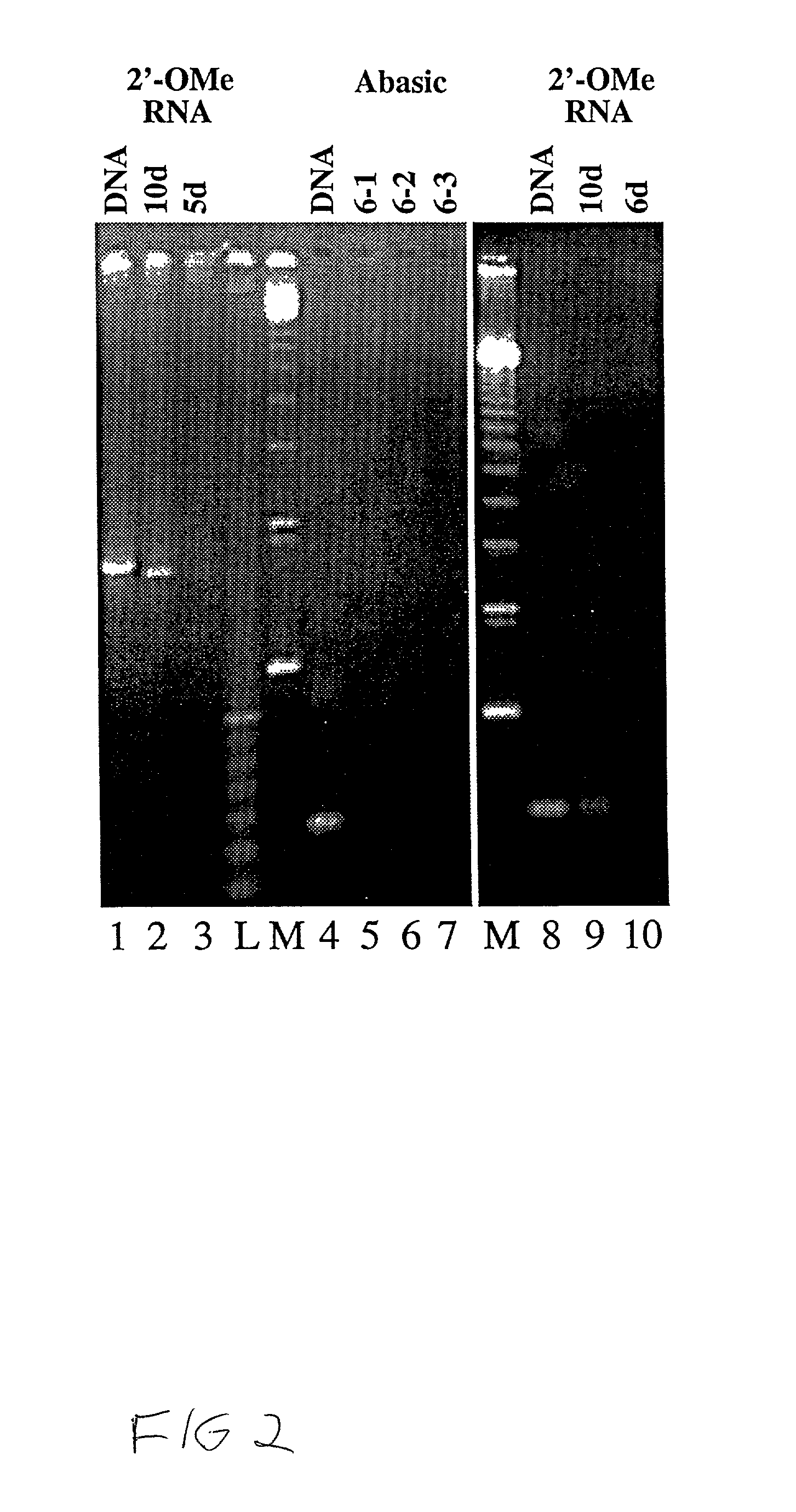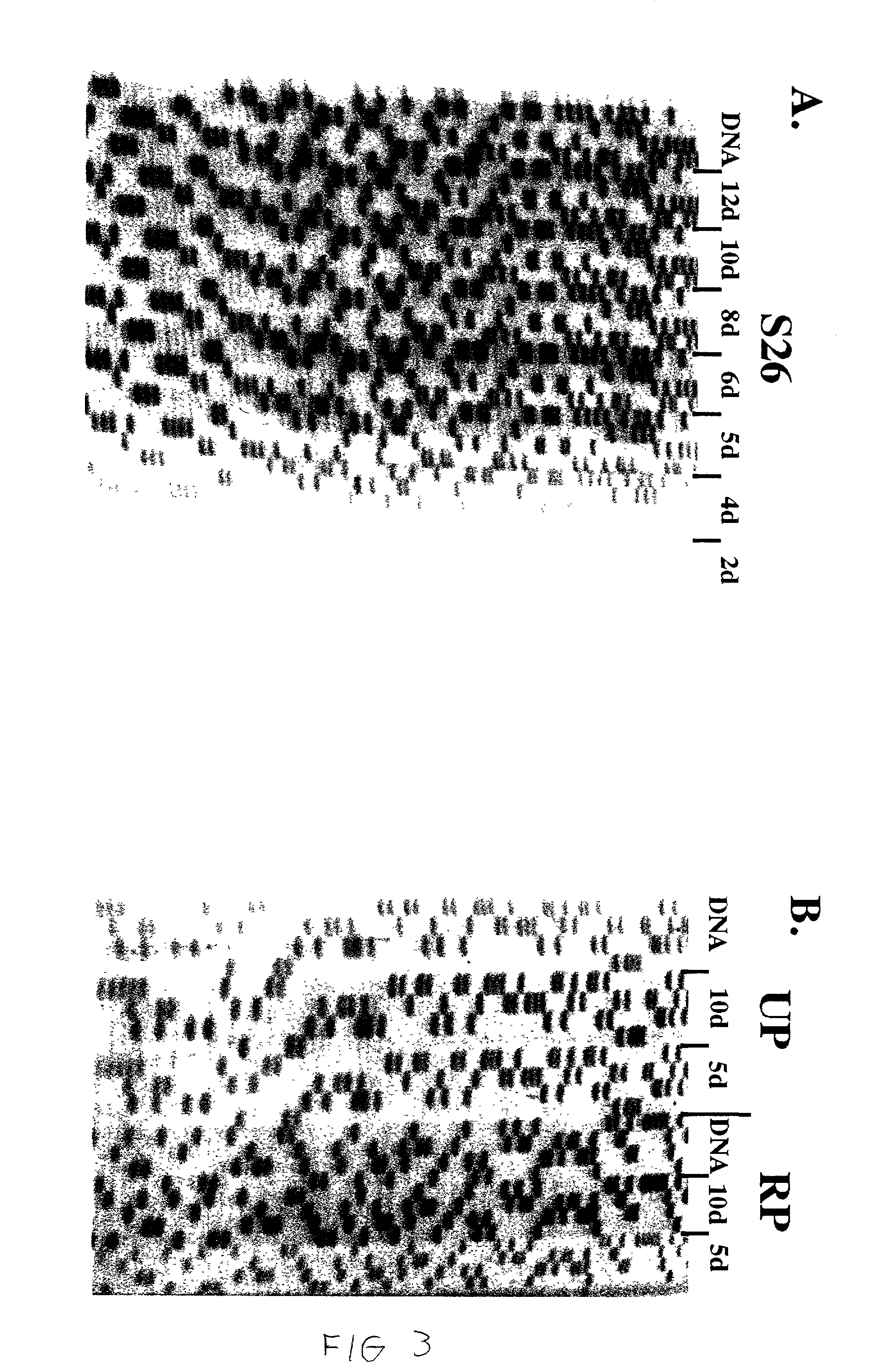Use of primers containing non-replicatable residues for improved cycle-sequencing of nucleic acids
a technology of primers and nucleic acids, applied in the field of primers for use in sequencing dna, can solve the problems of generating artifacts by exponential amplification, traditional methods of dna sequencing, and unable to work well,
- Summary
- Abstract
- Description
- Claims
- Application Information
AI Technical Summary
Problems solved by technology
Method used
Image
Examples
example 1
Polymerase Chain Reaction (PCR) with Modified Oligonucleotides
[0049] Amplification consisted of 25 cycles of 15 seconds at 96.degree. C., 15 seconds at 60.degree. C., and 3 minutes at 72.degree. C. in an MJ Thermocycler. Reactions were carried out in 20 .mu.l containing 100 fmol of template, 10 pmol of each primer, 200 .mu.M dNTPs, 1.4 .mu.g of Taq DNA polymerase modified as described in S. Tabor & C. C. Richardson, Proc. Natl. Acad. Sci. USA 92:6339-6343 (1995), 0.01 units of pyrophosphatase from Thermoplasma acidophilum, 2.75 mM MgCl.sub.2, 10 mM Tris-HCl, pH 9.2, and 100 mM KCl. The template for the UP-RP series of primers was pGEM-3Zf(+) and for the S26-K26 series was KS52. Reactions were analyzed on 3% Nusieve GTG gels (FMC).
[0050] Referring to FIG. 1, a model of the failure of PCR using primers containg 2'-O-Me RNA residues is presented. The solid dark lines represent the template. The boxed areas are the primers. The open boxed areas are DNA residues of the primer. The shaded...
example 2
DNA Sequencing with Chimeric Primers
[0055] In order to determine the relative efficiencies with which the chimeric DNA / 2'-O-Me RNA oligonucleotides could be used as primers by Taq polymerase, sequencing reactions were attempted. Primers were end-labeled with [.gamma.-.sup.32P] ATP and T4 polynucleotide kinase. Unless otherwise noted, the thermal cycle sequencing reactions were performed as follows. Sequencing reaction mixes contained 25 fmol of template, 1.25 pmol of labeled primer, 2.75 mM MgCl.sub.2, 10 mM Tris-HCl, pH 9.2, 100 mM KCl, 0.01 U of pyrophosphatase, and 1.4 .mu.g of Taq polymerase, 125 .mu.M of each dNTP and either ddATP, ddGTP, ddCTP, or ddTTP at 1 .mu.M in a total volume of 20 .mu.l. Thermal cycling consisted of 25 cycles of 10 seconds at 96.degree. C., a 1.degree. / second ramp to 50.degree. C., 15 seconds 50.degree. C., a 1.degree. / second ramp to 60.degree. C., and 4 minutes at 60.degree. C. The template, pWD42a, is a 5.2 kb plasmid with an 8 kb insert and an RI ori...
example 3
Artifact Elimination with Chimeric Primers
[0058] The above data suggest that the use of chimeric DNA / 2'-O-Me RNA primers in a sequencing reaction might yield good sequencing ladders while preventing artifacts that are due to exponential amplification. This possibility was tested using several primer pairs on a single template. Two primers are used in each experiment. Each primer can hybridize to the template, but only one primer is labeled. Two informative sequencing ladders may be produced, but only one is visualized.
[0059] The left side of FIG. 5 shows the results from using the K26 and S26 primers together in a sequencing reaction. The template for the reaction was one that had led to a variety of artifact bands using the conventional DNA primers. In this experiment the .sup.32P-labeled S26-DNA primer and unlabeled K26-DNA primer were combined with pWD42a in a sequencing reaction. The sequencing ladder can be partially read but is greatly obscured by a number of undesired product...
PUM
| Property | Measurement | Unit |
|---|---|---|
| melting temperatures | aaaaa | aaaaa |
| pH | aaaaa | aaaaa |
| total volume | aaaaa | aaaaa |
Abstract
Description
Claims
Application Information
 Login to View More
Login to View More - R&D
- Intellectual Property
- Life Sciences
- Materials
- Tech Scout
- Unparalleled Data Quality
- Higher Quality Content
- 60% Fewer Hallucinations
Browse by: Latest US Patents, China's latest patents, Technical Efficacy Thesaurus, Application Domain, Technology Topic, Popular Technical Reports.
© 2025 PatSnap. All rights reserved.Legal|Privacy policy|Modern Slavery Act Transparency Statement|Sitemap|About US| Contact US: help@patsnap.com



